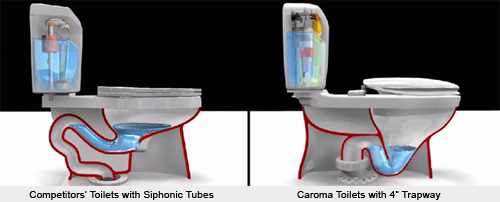 One of the first things we replaced in our home were the toilets. We originally had one piece Toto fixtures that the previous owner had put in, which were fine, but for us, at 1.6 gpm, still consumed more water then we wanted. Our logic? Since a majority of toilet uses are for flushing non-solid waste, it seems very wasteful to use a whole gallon and a half of potable water (don’t get me started on the lack of greywater usage in this country) to flush when so little is really necessary to be effective.
One of the first things we replaced in our home were the toilets. We originally had one piece Toto fixtures that the previous owner had put in, which were fine, but for us, at 1.6 gpm, still consumed more water then we wanted. Our logic? Since a majority of toilet uses are for flushing non-solid waste, it seems very wasteful to use a whole gallon and a half of potable water (don’t get me started on the lack of greywater usage in this country) to flush when so little is really necessary to be effective.
What we found in our research was that it wasn’t just about it being a low-flow toilet alone, it had a lot of do with the technology, or lack thereof, of the toilet itself.
You see, ‘american’ toilets were originally designed to flush on large volumes of water. The reason being? Siphon drains; that goose-neck looking curve along the back of your toilets drain. You see, the water, when it flows down the drain, creates an air bubble that gets pulled down the drain, thus creating a suction, and therefore a swirling effect in the toilet. This process takes a good volume of water just to create the air bubble and requires more water to ensure that the waste is taken down in the swirl it creates. This is why older toilets used over 6 gallons of water per flush. Can you believe that? Just to flush our waste! How dumb.
Then what happened is, regulations started requiring them to use less water. Starting in 1994, toilets were required to use 1.6 gpf or less. Well, the issue was that that was significantly less water then the technology was designed to handle. So what you had were toilets that didn’t flush waste very well, clogged easily or, as introduced in the late 1990’s, power assisted or air assisted in order for them to work… BAWOOSH they screamed… Scaring the crap out of you. Very effective but startling. There had to be a better way.
 Well, for the last 20 years, there has been a company in Australia that has been making what is called Dual-Flush toilets. These toilets have two flush options, one is 0.8 gpf (now 0.6) and 1.6 gpf (now 1.2). This allows you to use less water to flush non-solid waste. But here is the kicker, I have found through use at our house, that i have NEVER had to use the full flush mode for any reason. The half-flush is enough to flush any waste down the toilet. The reason is, they use a direct ‘S’ trap for the drain. Very simple and it only requires enough water to push the waste up and over the trap. And that trap is 4″, enough to flush a softball (not that i recommend this).
Well, for the last 20 years, there has been a company in Australia that has been making what is called Dual-Flush toilets. These toilets have two flush options, one is 0.8 gpf (now 0.6) and 1.6 gpf (now 1.2). This allows you to use less water to flush non-solid waste. But here is the kicker, I have found through use at our house, that i have NEVER had to use the full flush mode for any reason. The half-flush is enough to flush any waste down the toilet. The reason is, they use a direct ‘S’ trap for the drain. Very simple and it only requires enough water to push the waste up and over the trap. And that trap is 4″, enough to flush a softball (not that i recommend this).
By putting in Caroma One-piece Dual Flush toilets, we were able to cut our water usage for toilets in half. Even if you don’t achieve that level, it is at least a 60% reduction under standard usage. You can get Caroma Toilets from Dana Jones at Sunstate Sales here in Phoenix. You can reach them at (602) 484-7148.
Just remember that not all Dual Flush systems are the same. The secret is in the less sophisticated but more intelligent trap design in the Caroma toilets. Until the rest figure that out, it is Apples to Melons. It is amazing the insight that Australians have about conserving water. You should always start down under when looking for water conserving technology.
Tell Dana, i said hello. He is a great guy and takes great care of his clients.




